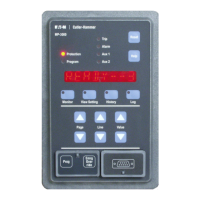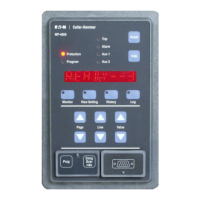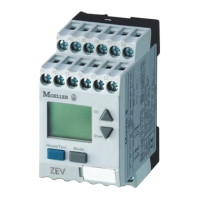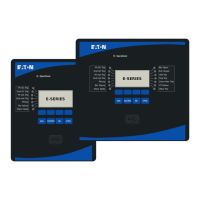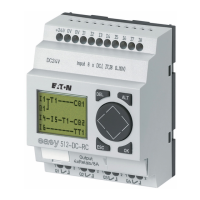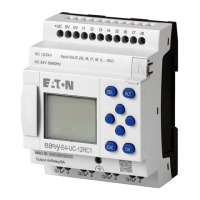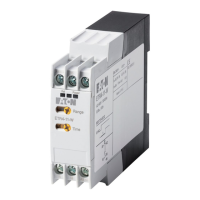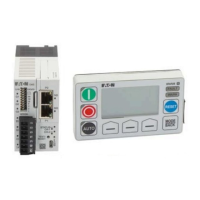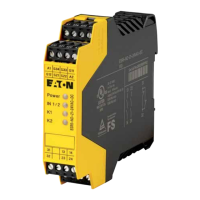For more information visit: www.cutler-hammer.eaton.com
Page 5-9
Effective 10/02 IL17562BH04
the relay AUX1 is dedicated to this function and other uses are not
available or visible.
The load shed function provides a contact output signal that the user
connects to the process equipment, to reduce loading on the motor if
it becomes too large. For example, the contact might be used to
temporarily stop the flow of heavy materials onto a conveyor driven by
the protected motor. In this way, the MP-3000 tries to alleviate an
overload before it reaches an outright thermal protective trip. When
the load is reduced, the contact returns to the normal state and the
process can resume loading of the motor.
The load shed function, which is active only during the RUN state of
the motor, is configured with the following three settings:
5.9.1 Setting P9L1, Load Shed Pickup Current (LSPU)
Sets current level above which the load shed output is activated.
5.9.2 Setting P9L2, Load Shed Dropout Current (LSDO)
Sets current level below which the load shed output is deactivated.
5.9.3 Setting P9L3, Load Shed Delay (LSDL)
Sets both the pickup and dropout delays in seconds for the load shed
output. In other words, it sets the time for which the current must be
above LSPU before the output is activated; and also sets the time for
which the current must be below LSDO before the output is deacti-
vated.
The LSPU and LSDO settings are forced to be coherent:
• If the user sets either to OFF, the other is automatically set to OFF
as well.
• If LSPU is set to any pickup value with LSDO OFF then LSDO is set
to its minimum on-setting, 50 percent of FLA. User can then set it to
a different value if desired.
• If LSDO is set to any dropout value with LSPU OFF then the LSPU
is set to its maximum value, 150 percent of FLA. User can then set
it to a different value if desired.
• LSPU must be greater than LSDO. Setting range of either may be
limited to enforce this.
5.9.4 Settings P9L4 through P9L25, Alarm and Trip assignments
to AUX1
If LSPU and LSDO are both set to OFF, all other available functions for
AUX1 become visible and can be individually turned on or off. AUX1 is
activated if any of the designated functions picks up, with an OR logic
function. Other than the three load shed function settings, the remaining
settings are the same as the 22 listed for SP AREL page in Section 5.8.
The AUX1 output operates if any of the selected functions become true.
5.10 Page 10, SP AUX2, Settings P10L1 to P10L23
This page determines which events activate the output relay AUX2. It
also includes the setting to enable the transition function. The factory
settings configure AUX2 to pick up for the transition function.
NOTE
THE OPERATING SPECIFICS OF THE TRANSITION FUNCTION
MUST BE CONFIGURED ON THE SP START PAGE 5, SETTINGS
P5L5 TO P5L9, IF THE TRANSITION FUNCTION IS SET ON HERE
WITH P10L1.
5.10.1 Setting P10L1, Enable transition control output (TRN ON or
TRN OFF)
Enables the transition function through output relay AUX2. If ON, the
AUX2 relay is activated when the motor transitions from the START
state to the RUN state, and deactivated when the next motor STOP is
declared. Consider MODE 1 versus MODE 2 activation as set by
P12L4 below.
5.10.2 Settings P10L2 through P10L23, Alarm and Trip assign-
ments to AUX2
If the transition function is OFF, then all the other functions for AUX2
are visible. The settings are the same 22 selections as those in the
SP AREL page—see Section 5.8. The AUX2 output operates if any of
the selected functions become true.
5.11 Page 11, SP A OUT
Configures the operation of the 4-20 mA analog output.
5.11.1 Setting P11L1, Analog Output Function (MAX XXXX)
Selects the internal MP-3000 parameter represented by the 4-20 mA
analog output. Select one of four choices:
MAX 100–100 percent of FLA—proportional to the average of the
three-phase current values, with 100 percent of FLA = 20 mA and zero
percent = 4 mA.
MAX 125–125 percent of FLA—proportional to the average of the
three-phase current values, with 125 percent of FLA = 20 mA and zero
percent = 4 mA.
MAX %I2T–Percent of
I2T Trip Level—proportional to the percent
I2T
trip level (thermal-model accumulator bucket), with 100 percent of the
I2T Trip Level = 20 mA and zero percent = 4 mA.
MAX WRTD—Winding temperature—proportional to the maximum
winding RTD temperature from the URTD module. The winding RTD
trip level (setting P2L2) = 20 mA and zero degrees C or 32 degrees F =
4 mA.
5.12 Page 12, SP SYS, Settings P12L1 to P12L18
This page configures overall operation of the MP-3000.
5.12.1 Setting P12L1, Configure Trip Relay Output (TP MODE1 or
TP MODE2)
Selects:
MODE 1—trip relay is normally de-energized. Energize the trip relay
on a trip event.
MODE 2—energize the trip relay on power up and de-energize the trip
relay on a trip event. Also called fail-safe mode. This is the factory-set
mode.
Keep in mind that each of the output relays has a form c (SPDT)
contact set, so that combining output modes and contact choices
gives four logical combinations. Note the key difference in using Mode
2 with the normally-open contact versus using Mode 1 with the
normally-closed contact. With Mode 2 and a normally-open contact,
the external circuit is closed during normal non-trip operation, and
opens for a trip, if the MP-3000 power supply is de-energized, or the
product fails. With Mode 1 and a normally-closed contact, the external
circuit opens only for an overt trip decision, and is maintained when
the MP-3000 is de-energized.
